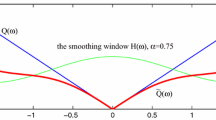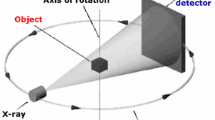Abstract
We present a new algorithm for reconstructing binary images from their projections along a small number of directions. Our algorithm performs a sequence of related reconstructions, each using only two projections. The algorithm makes extensive use of network flow algorithms for solving the two-projection subproblems.
Our experimental results demonstrate that the algorithm can compute highly accurate reconstructions from a small number of projections, even in the presence of noise. Although the effectiveness of the algorithm is based on certain smoothness assumptions about the image, even tiny, non-smooth details are reconstructed exactly. The class of images for which the algorithm is most effective includes images of convex objects, but images of objects that contain holes or consist of multiple components can also be reconstructed very well.
Similar content being viewed by others
References
R.K. Ahuja, T.L. Magnanti, and J.B. Orlin, Network Flows: Theory, Algorithms, and Applications, Prentice-Hall, 1993.
R.P. Anstee, “The network flows approach for matrices with given row and column sums”, Discrete Math., Vol. 44, pp. 125–138, 1983.
E. Barcucci, A. Del Lungo, M. Nivat, and R. Pinzani, “Reconstructing convex polyominoes from horizontal and vertical projections”, Theoret. Comput. Sci., Vol. 155, pp. 321–347, 1996.
K.J. Batenburg, “A new algorithm for 3D binary tomography”,in Proceedings of the Workshop on Discrete Tomography and its Applications, New York, Electron. Notes Discrete Math., Vol. 20, 2005, pp. 247–261.
S. Brunetti, A. Del Lungo, F. Del Ristoro, A. Kuba, and M. Nivat, “Reconstruction of 4- and 8-connected convex discrete sets from row and column projections”, Linear Algebra Appl., Vol. 339, pp. 37–57, 2001.
S. Brunetti and A. Daurat, “An algorithm for reconstructing lattice convex sets”, Theoret. Comput. Sci., Vol. 304, pp. 35–57, 2003.
P. Fishburn, P. Schwander, L. Shepp, and R. Vanderbei, “The discrete Radon transform and its approximate inversion via linear programming”, Discrete Appl. Math., Vol. 75, pp. 39–61, 1997.
H.N. Gabow and R.E. Tarjan, “Faster scaling algorithms for network problems”, SIAM J. Comput., Vol. 18, pp. 1013–1036, 1989.
D. Gale, “A theorem on flows in networks”, Pacific J. Math., Vol. 7, pp. 1073–1082, 1957.
R.J. Gardner, Geometric Tomography, Cambridge University Press, New York, 1995.
R.J. Gardner and P. Gritzmann, “Discrete tomography: determination of finite sets by X-rays”, Trans. Amer. Math. Soc., Vol. 349, pp. 2271–95, 1997.
R.J. Gardner, P. Gritzmann, and D. Prangenberg, “On the computational complexity of reconstructing lattice sets from their X-rays”, Discrete Math., Vol. 202, pp. 45–71, 1999.
A.V. Goldberg, “An efficient implementation of a scaling minimum-cost flow algorithm”, J. Algorithms, Vol. 22, pp. 1–29, 1997.
P. Gritzmann, S. de Vries, and M. Wiegelmann, “Approximating binary images from discrete X-rays”, SIAM J. Optim., Vol. 11, pp. 522–546, 2000.
P. Gritzmann, D. Prangenberg, S. de Vries, and M. Wiegelmann, “Success and failure of certain reconstruction and uniqueness algorithms in discrete tomography”, Int. J. Imag. Syst. Tech., Vol. 9, pp. 101–109, 1998.
L. Hajdu and R. Tijdeman, “Algebraic aspects of discrete tomography”, J. Reine Angew. Math., Vol. 534, pp. 119–128, 2001.
L. Hajdu and R. Tijdeman, “An algorithm for discrete tomography”, Linear Algebra Appl., Vol. 339, pp. 147–169, 2001.
G.T. Herman and A. Kuba, (Eds.), Discrete Tomography: Foundations, Algorithms and Applications, Birkhäuser, Boston, 1999.
J.R. Jinschek, K.J. Batenburg, H. Calderon, D. Van Dyck, F.-R. Chen, and C. Kisielowski, “Prospects for bright field and dark field electron tomography on a discrete grid”, Microsc. Microanal., Vol. 10 Suppl. 3, Cambridge Journals Online, 2004.
J.R. Jinschek, H.A. Calderon, K.J. Batenburg, V. Radmilovic and C. Kisielowski, “Discrete Tomography of Ga and InGa Particles from HREM Image Simulation and Exit Wave Reconstruction”, MRS Proc., Vol. 839, pp. 4.5.1–4.5.6, 2004.
C. Kisielowski, P. Schwander, F. Baumann, M. Seibt, Y. Kim, and A. Ourmazd, “An approach to quantitative high-resolution transmission electron microscopy of crystalline materials”, Ultramicroscopy, Vol. 58, pp. 131–155, 1995.
H.J. Ryser, “Combinatorial properties of matrices of zeros and ones”, Canad. J. Math., Vol. 9, pp. 371–377, 1957.
A. Schrijver, Combinatorial Optimization. Polyhedra and Efficiency, Springer-Verlag, Berlin, 2003.
P. Schwander, C. Kisielowski, F. Baumann, Y. Kim, and A. Ourmazd, “Mapping projected potential, interfacial roughness, and composition in general crystalline solids by quantitative transmission electron microscopy”, Phys. Rev. Lett., Vol. 71, pp. 4150–4153, 1993.
C.H. Slump and J.J. Gerbrands, “A network flow approach to reconstruction of the left ventricle from two projections”, Comput. Gr. Im. Proc., Vol. 18, pp. 18–36, 1982.
K. Tanabe, “Projection method for solving a singular system”, Numer. Math., Vol. 17, pp. 203–214, 1971.
B. Wang and F. Zhang, “On the precise number of (0,1)-matrices in A(R,S)”, Discrete Math., Vol. 187, pp. 211–220, 1998.
S. Weber, C. Schnörr, and J. Hornegger, “A linear programming relaxation for binary tomography with smoothness priors”, Electron. Notes Discrete Math., Vol. 12, 2003.
Author information
Authors and Affiliations
Corresponding author
Additional information
Kees Joost Batenburg received his PhD degree in Mathematics from the University of Leiden, The Netherlands, in 2006. He also holds a M.Sc. degree in Computer Science. From 2002 to 2006 he worked as a PhD student at CWI in Amsterdam and at the University of Leiden. He is currently a postdoctoral researcher at the Vision Lab of the University of Antwerp, Belgium.
His research interests include theory and applications of discrete tomography, combinatorial optimization and natural computing (evolutionary algorithms, neural networks).
Rights and permissions
About this article
Cite this article
Batenburg, K.J. A Network Flow Algorithm for Reconstructing Binary Images from Discrete X-rays. J Math Imaging Vis 27, 175–191 (2007). https://doi.org/10.1007/s10851-006-9798-2
Published:
Issue Date:
DOI: https://doi.org/10.1007/s10851-006-9798-2




